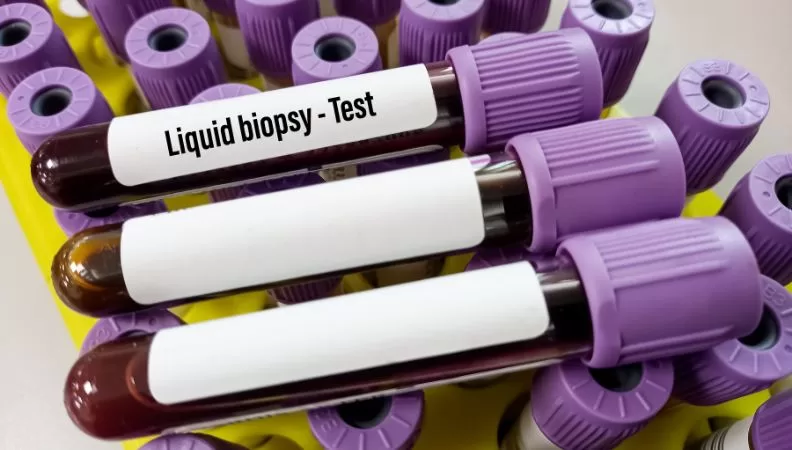Liquid Biopsy: A Revolutionary Non-Invasive Approach to Cancer Detection
Cancer detection has traditionally relied on invasive tissue biopsies, which are potentially painful, expensive, and dangerous. Liquid biopsy for cancer detection, however, is emerging as a paradigm-shifting complementary approach. It provides a non-invasive, effective, and precise tool for early cancer detection, tracking its progression, and establishing personalized therapies. This state-of-the-art technique identifies circulating tumor DNA (ctDNA), exosomes, and other biomarkers in a patient’s blood, urine, or other body fluids, eliminating the need for surgical procedures. As a result, liquid biopsy for cancer detection is revolutionizing cancer diagnostics, offering a safer and more accessible alternative.
In this article, we will explore the science behind liquid biopsy, its advantages over traditional methods, its role in early cancer detection, and the challenges that must be addressed before it becomes a standard diagnostic tool worldwide.
Understanding Liquid Biopsy and How It Works
Liquid biopsy is an innovative technique that positive cancer from blood, urine, or saliva instead of the biopsy of tissue. This method is based on the disclosure of circulating tumor cells (CTCs), cell-free DNA (cfDNA), exosomes, and other tumor-derived genetic fragments.
The Science Behind Liquid Biopsy and Cancer Detection
Liquid biopsy is based on identifying cell fragments of DNA, RNA, and protein shed by cancer cells in body fluids. Sophisticated sequencing technology examines such materials, and discovers cancer-specific genetic alterations and biomarkers to stage disease, track disease progression, and inform treatment.
Key Biomarkers Used in Liquid Biopsy for Cancer Diagnosis
Circulating Tumor DNA (ctDNA): Small fragments of genetic material released by tumor cells.
Circulating Tumor Cells (CTCs): Whole cancer cells found in the bloodstream.
Exosomes and microRNA (miRNA): Tiny vesicles and RNA molecules that regulate cancer genes.
Types of Liquid Biopsy Tests and Their Applications
ctDNA Tests: Used to detect cancer mutations and monitor treatment effectiveness.
CTC-Based Tests: Help identify cancer presence and progression.
Exosome-Based Tests: Provide insights into tumor behavior and resistance mechanisms.
How Liquid Biopsy Improves Cancer Diagnosis and Treatment
Liquid biopsy is transforming the treatment of cancer by offering a speedier, safer, and more accurate diagnosis than the conventional approach.
Early Cancer Detection Through Liquid Biopsy Testing
Detecting cancer at an early stage increases survival rates. Liquid biopsy is able to detect the neoclassical cancerous mutations even before symptoms can occur, enabling an early intervention.
Identifying Cancer Type and Genetic Mutations for Treatment
Liquid biopsy plays an important role in identifying characteristic cancer and genetic mutations, leading to the individualized targeted therapy plan.
Tracking Treatment Response and Therapy Effectiveness
Moreover, changes in ctDNA levels can be analyzed by doctors and used to assess a patient’s response to therapy. Additionally, this helps determine if treatment adjustments are necessary. Furthermore, it enables personalized cancer care. Meanwhile, ongoing monitoring improves treatment outcomes. Ultimately, liquid biopsy enhances precision medicine.
Detecting Cancer Recurrence and Monitoring for Relapse
For example, healthcare workers can use handheld ultrasound machines, blood pressure monitors, and rapid diagnostic tests for diseases like malaria and tuberculosis in the field, allowing them to diagnose and treat patients on-site without needing a lab.
Comparing Liquid Biopsy and Traditional Biopsy Methods
While traditional tissue biopsy remains the gold standard, liquid biopsy is faster, safer, and more convenient for patients.
Minimally Invasive Alternative to Tissue Biopsy Procedures
Unlike surgical tissue biopsies (which necessitate resection) liquid biopsy relies only on collecting a blood sample, which is less painful and prone to complications.
Faster Diagnosis and Real-Time Cancer Monitoring
Traditional biopsies can take weeks. However, liquid biopsy delivers results within days, thus allowing for quicker diagnosis and treatment planning. Moreover, this speed reduces patient anxiety. Additionally, it enables timely medical interventions. Furthermore, liquid biopsy is less invasive. Ultimately, it improves overall cancer care efficiency.
Continuous Tracking of Tumor Progression and Genetic Changes
Liquid biopsy enables ongoing monitoring, and detection of genetic mutations in real time to guide personalized treatment strategies.
Overcoming Limitations of Tissue Biopsy for Some Cancers
In some cases, tumors are untouchable or too dangerous for biopsy. Liquid biopsy provides a viable alternative for hard-to-reach cancers.
Types of Cancer That Can Be Detected Using Liquid Biopsy
Liquid biopsy is shown to be successful in detecting and tracking several cancer types.
Using Liquid Biopsy for Early Lung Cancer Detection
For example, healthcare workers can use handheld ultrasound machines, blood pressure monitors, and rapid diagnostic tests for diseases like malaria and tuberculosis in the field, allowing them to diagnose and treat patients on-site without needing a lab.
How Liquid Biopsy Helps in Breast Cancer Monitoring
Liquid biopsy is helpful to breast cancer patients tracking the tumor progression and treatment response, without the necessity of repeated surgeries.
Detecting Colorectal Cancer Through Blood-Based Testing
Moreover, liquid biopsy captures colorectal cancer-specific DNA markers and therefore reduces reliance on invasive colonoscopies. Additionally, it offers a less painful alternative for early detection. Furthermore, this approach improves patient compliance. Ultimately, liquid biopsy enhances diagnostic accuracy and convenience.
Prostate Cancer Detection and Progress Monitoring
Liquid biopsy can be used by advanced prostate cancer patients to measure disease course and treatment response longitudinally.
Challenges and Limitations of Liquid Biopsy Technology
Although promising, liquid biopsy has certain limitations that need to be overcome before general use.
Ensuring High Accuracy and Sensitivity in Liquid Biopsy
Finding small amounts of ctDNA is not easy, which could result in spurious positives or negatives in certain cases.
Reducing Costs and Expanding Access to Liquid Biopsy
Liquid biopsy tests are expensive and currently unavailable at a large scale making access difficult in low and middle-income areas.
Standardization and Regulatory Approval Challenges
Moreover, global regulatory approval and standardization of liquid biopsy methodology are in high demand. Additionally, establishing uniform guidelines ensures reliability in clinical practice. Furthermore, standardization enhances accuracy and consistency. Meanwhile, ongoing research supports its integration. Ultimately, these efforts will improve patient outcomes.
Addressing the Need for More Research and Clinical Trials
Additional study is needed to confirm liquid biopsy in other cancers and optimize its clinical use.
Future Innovations in Liquid Biopsy and Cancer Research
The direction of liquid biopsy is very encouraging. Meanwhile, research and development in AI, sequencing technology, and precision medicine are advancing. Additionally, these innovations enhance accuracy and efficiency. Furthermore, ongoing studies continue to refine their applications. Ultimately, liquid biopsy is shaping the future of cancer detection and treatment.
Next-Generation Sequencing for More Accurate Results
With the increasing sensitivity and specificity of liquid biopsy, the diagnosis is becoming increasingly accurate.
AI and Machine Learning Enhancing Liquid Biopsy Accuracy
For example, healthcare workers can use handheld ultrasound machines, blood pressure monitors, and rapid diagnostic tests for diseases like malaria and tuberculosis in the field, allowing them to diagnose and treat patients on-site without needing a lab.
Expanding Liquid Biopsy Applications to More Cancer Types
Research is broadening the scope of liquid biopsy beyond the existing cancers and may be useful in detecting pancreatic, brain, and rare cancers.
The Role of Liquid Biopsy in Personalized Cancer Treatment
Liquid biopsy will have an important contribution to precision medicine with a highly personalized treatment plan on each individual patient’s unique genetic profile.
Conclusion
Liquid biopsy has sparked a paradigm shift in cancer diagnosis and therapy, providing a non-invasive, speedy, and highly concordant alternative to standard biopsies. Notwithstanding present challenges, development in genomics, AI, and precision medicine is anticipated to improve its robustness and accessibility. With research advances, liquid biopsy is poised to become an everyday instrument in oncology, aiding early diagnosis and survival for millions of cancer patients worldwide.



